Details of the Flexi bag biogas system
I got a comment from Stephen Kamau who says
“EYE WITTNESS-This system really works.I bought the system through M-pesa after visiting a home in Transmara where i found Dominic stiring cow shit, and when he explained how it works,i decided to purchase. I installed it myself with my wife giving hand when i needed help and, after three weeks there was more gas than what our kitchen requires.
Thank you for the easiest technology.”
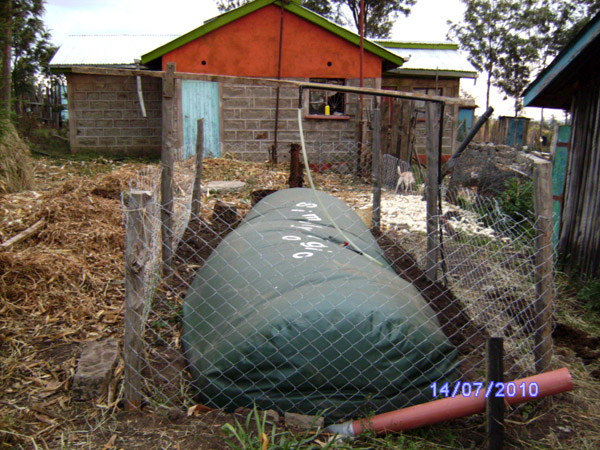 And here’s his proud construction
And here’s his proud constructionThis blog is for all those people who want a share of Stephens joy.

Everyone who has seen my biogas system above, has asked how to get one. Loads of people want to buy one for their mother back in the village. Yes you can have one!
If you’d like to order it, simply call Dominic 0722 700 530 to place your order or email him Dominic Wanjihia dwanjihia@yahoo.com. The costs vary but range from Ksh 45,000 to 55,000. Specifics can all be found here on the Simply Logic official website http://www.biogas.co.ke/
Start with basics. What is biogas?
Biogas is the gas produced by the biological breakdown of organic matter through fermentation. The gas is made up of methane (CH4) and carbon dioxide (CO2). Methane is highly combustible with oxygen when in contact with air. This occurs in anaerobic conditions which is in the absence of oxygen.
Biogas can be produced from a variety of materials such as manure, sewage, garden and kitchen wastes, and yes, your own dung.
Methane biogas burns hotter than butane with a beautiful blue hue – it helps to have someone beautiful to cook for you too (no that’s not me).
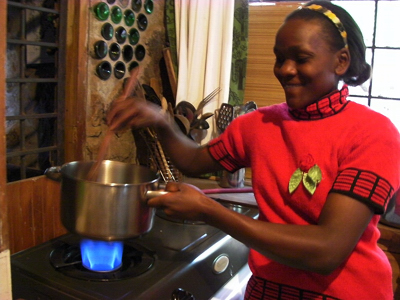
Thus, biogas is a low-cost fuel which can be used for any heating purpose, such as cooking and boiling water.
Justification for biogas use in Kenya
Everyone knows that Kenyas forests are disappearing because of charcoal and even though it’s leading to climate change, water shortages and power cuts, yet everyone still uses charcoal!
Some scary facts
- It is estimated that wood makes up 95% of domestic energy use in Kenya.
- The per capita use of wood is 1 ton per year! Crikey there are more than 40 million of us now!What about next year and the next and on and on….
- Natural replacement rates of wood fuel are estimated to be less than 60% – ie wood supplies are disappearing by 40 % each year in Kenya.
- Given the above, there will be no (affordable) charcoal in the near future. We need alternative affordable energy.
Actually biogas can be produced from any biological waste so rural farmers and pastoral communities can produce more than enough energy though biogas if they just had digesters… that’s where we come in
The miracle of Biogas
Before you get too excited let me remind you that biogas is not a new concept. Ancient Persians observed that rotting vegetables produce flammable gas and in 1859 Indians built the first sewage plant in Bombay. Biogas has been used in China for 2,000–3,000 years. It’s just that we in Kenya are ridiculously slow in adopting appropriate and obvious technology.
Two types of biogas digesters have been previously promoted in Kenya. The floating dome type from India and fixed dome types from China. Both are used widely in their home countries but haven’t done all that well here.
Studies have been done to find out why Kenyans don’t take to biogas and have come up with several reasons -
- Fixed dome and floating top systems are very expensive to install with costs ranging from Kes 150,000 and upwards for domestic systems. Ie. it’s just too expensive.
- They require technical expertise in construction which requires masonry stones and cement. It can take several days or weeks to construct. This adds to the cost and sheer scaryness of it.
- Metal parts of the dome are prone to rusting requiring regular repair or replacement
- Since it’s a construction, the user must own the land due to the construction requirements
- Parts are bulky requiring expensive truck transportation – we all know what a rip off it is to hire a pick up or lorry
- Some of the parts are imported and are not locally produced or widely available
Enter the (Dominic) FLEXIGAB biogas digester
Dominic Wanjihia has been scratching his head about the energy problems in rural parts of Kenya. Just think about it, if you are reading this blog you probably have an obvious source of energy, electricity.
All you need is one energy source to provide you with all the conveniences you need – fridge, stove, hot water, lights. Without electricity your life would be severely compromised – no way to cool and store food, no way to work at night, watch TV, listen to radio, have a hot shower … and most of all, no way to work! But that’s how many Kenyans live. No wonder we are losing so much productivity.
After seeing piles of dung wasting away at Maasai Manyatta’s, and the owners lamenting the flies, Dominic wondered why they weren’t making and using biogas – afterall, the women spend hours fetching firewood. The simple reason – they didn’t know anything about it.
Building a fixed dome by a manyatta didnt’ seem all that acceptable or convenient, especially if the family moved, and getting materials into remote areas was another challenge. Then there’s the cost – the underground dome systems cost too many cattle. So started the flow of ideas – the Maasai needed something transportable, cheap and easy to operate,
That’s the true story of how the Flexibag biogas digester was born.
Dominic scratched his head some more, toured the juakali sector for materials, parts, ideas, pipes, and started sewing things together… testing what works and what doesn’t. We did a lot of research on the internet – bags have been used before but they failed due to light weight materials used. After many experiments and failures we now have something that works incredibly well.
The system Dom finally settled on is so simple it made him laugh. It comprises a heavy duty rubber bag as the digester. It sits mostly above ground and uses PVC pipes for inputs and outputs. Plastic gas pipes tap the gas from the digester and transfer it to the point of use. If the volume of gas is low the pressure can be increased by simply adding pressure to the biogas bag by placing 4 – 6 jerrycans full of sand on top (nothing with sharp edges should be used).
Some simple facts about WHY YOU SHOULD GET ONE OF THESE.
- It is cheap –
Ksh 28,000 (USD 400)Ksh 45,000 (sorry folks I’ve had to update this today for the new and much improved digesters (March 2nd 2011) – check Simply Logic Website for all updates on costings) for the bag and pipes making it affordable for domestic and small businesses (appliances are a separate cost).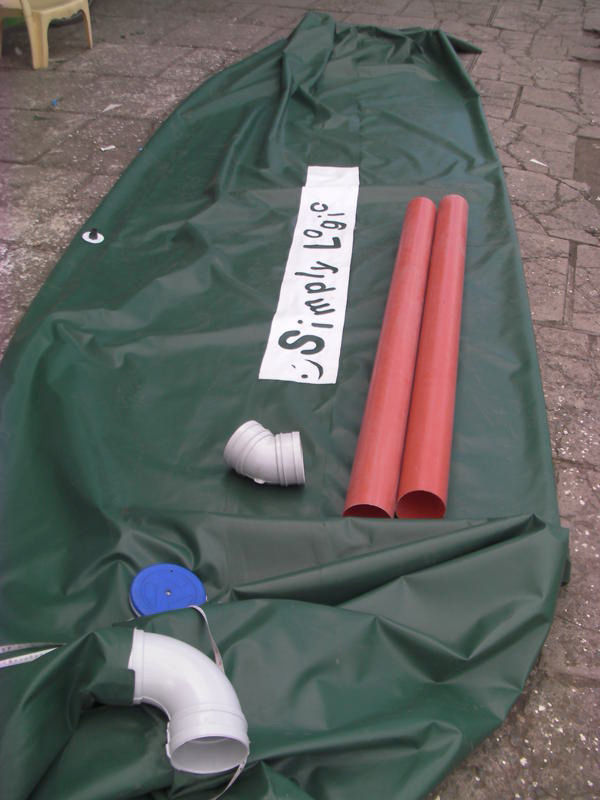
- Cooking appliances can run directly from the biogas after a slight modification.
- It is made from locally available and affordable materials. Ie there is no need for imported parts
- Durable – the envelope is made of a very strong rubberized textile which is tear resistant materials. To protected from sunlight with a layer of grass, and from livestock by surrounding with a small fence
- It is light weight and easily portable – this system can be quickly transported into rural areas weighing 10 kg and packs small enough to be carried on a bicycle or motorbike.
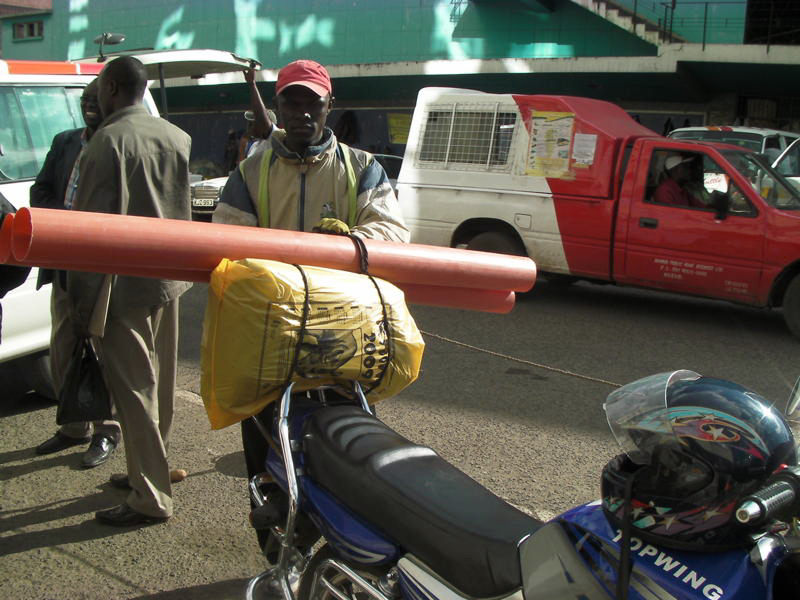
- If you decide to move it, it is easily transferrable. There is no masonry construction involved in setting up this system so the bag can be emptied, rolled up and moved to a new location.
- Installation is quick – the only requirement is to level a patch of ground. the time taken to install build the system is only a few minutes for roll out the envelope and connect pipes.
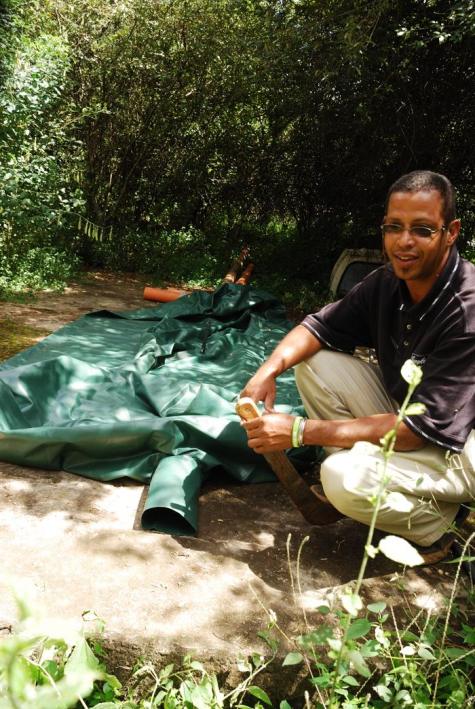
- In the event of rips, tears (vandalism) or broken pipes, repair of the system is easy, quick and cheap (no digging and masonry works)
- Biogas production is rapid – being above ground promotes rapid gas production attributed to the high temperatures achievable by direct sun exposure
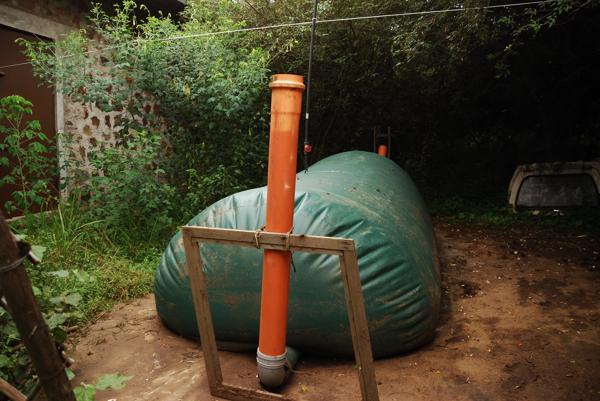 ‘
‘
We found that two big buckets of dung were enough to keep a household of 3 plus 4 dogs going continuously.
The pipe in the middle is the gas pipe – simply connect that to your gas stove* Note that this sytem will not work on those fancy Hotpoint cooker jobbies, we’re talking about 1 or 2 ring Mekko type stoves which are specially adapted for biogas which does not come under as much pressure as methane in a tank. Once modified the stove cannot be restored to a methane stove. We have also made special burners for ovens – special is an overstatement, they are so simple you will cry.
10. The envelope digester will produce and hold up to 5 cubic meters of gas which is adequate for one family cooking needs for 2 days. As long as dung is added daily the gas production can be maintained.
11. The capacity of the system is easily expanded – to increase gas capacity (eg for several houses, a village or school), simply add more flexi bags beside the initial one and connect with pipes.
12. The exhausted dung is emitted by the system automatically and has no bad odour (dung will need to remain in the bag for up to 3 months to be fully digested). It is channeled directly to the farm or vegetable patch where it can be used immediately (no further composting required).
13. This system can be adapted to include human wastes as well as kitchen wastes.
14. The cost of Flexibag system will be offset within 2 years afterwhich the cost of gas is free.
I did a simple calculation and worked it out
| Options | Cost (US$ ) | Time to install (days) | Labour | Maintenance | Durability |
| Fixed dome | 1,500 – 2000 | 21 | 5 people | Low | Decades |
| Floating top | 2,000 – 3,500 | 21 | 5 people | Low | Decades |
| Flexi bag envelope | 400 | 1 | 1 person | Low | 10 – 15 years |
| Fuelwood or LPG cylinders | 200 (per year) | 0 | 0 |
Yes it does. I’ve installed one at home and my gas cylinder is now idle. So many people want to know more about thow it works, and especially how to get one. Well, hopefully it’s all in this blog post
Source : http://wildaboutafrica.wordpress.com/2010/07/27/details-of-the-flexi-bag-biogas-system/


0 comments:
Post a Comment